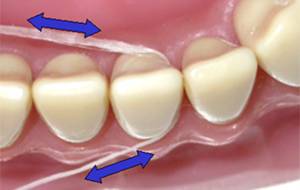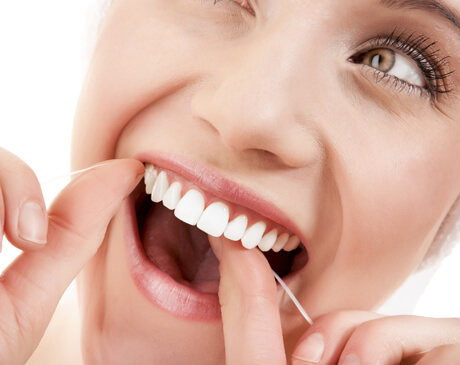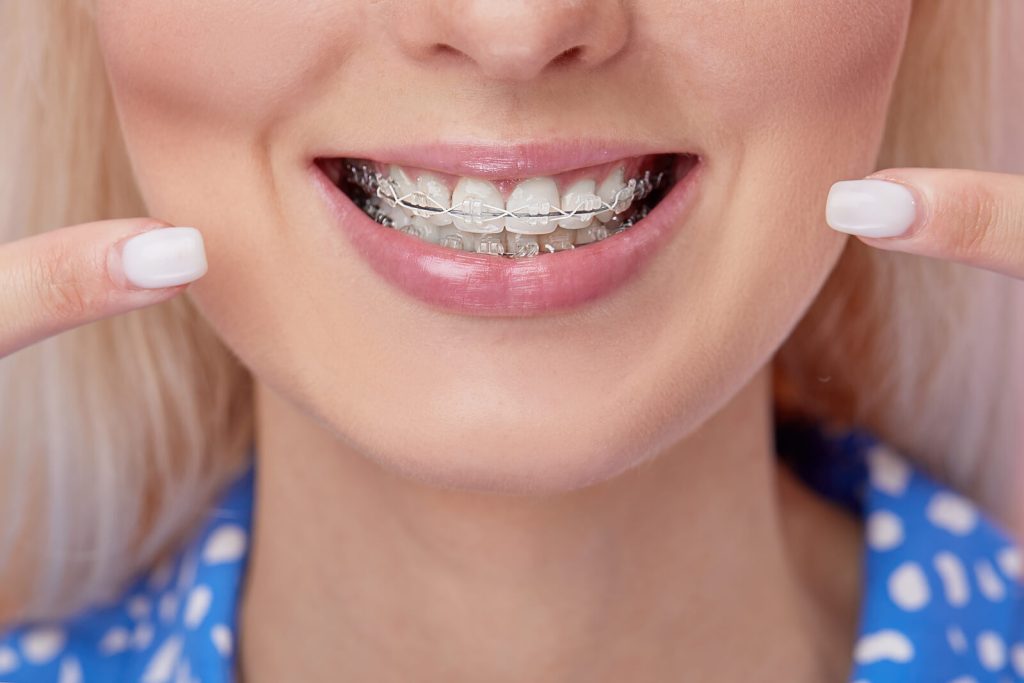If you do not currently floss you risk many issues, including gum disease, tooth decay and infection. Flossing may not be essential, but you should floss regularly if you want the best outcomes for your oral health. But how do you floss exactly? You have probably seen people in films or on television flossing, but what are they actually doing and how does it work?
Explained simply, flossing is the movement of a thread between the teeth – this unlodges what you cannot reach by brushing alone. A good flossing routine can give you many of the benefits that come from brushing, but the two together are the best recipe for optimal dental health – so, here we will tell you how to floss properly.
Before trying to floss for the first time, see below for an illustration of how flossing works:

To find out how to floss between your teeth the best way we have provided an amazingly comprehensive guide below.
For professional teeth cleaning, checkups or just some good dental advice at our Brighton and Hove clinic, please feel free to get in touch with us and book an appointment.
What Are the Benefits of Flossing?
Flossing is a typical modern practice but has been traced back to the early 1800s, for good reason! Flossing removes bits of food, bacteria and other things that can damage the teeth. Dental floss also helps to remove plaque, reduce bad breath and has many other preventative benefits. Overall, flossing is a vital part of good oral hygiene – so even if you floss only once in a while you will see some benefits.
How to Floss Properly
Many people struggle with the proper technique when brushing, flossing and even just rinsing their mouth. So, let’s get some basics right from our dental professionals…
To floss properly you need to use about 45 centimetres, or 18 inches, of floss. Wrap the floss around one of your forefingers, which is the index or ‘pointing’ finger, and hold the floss tight between your forefinger and thumb on the other hand. This clean section of floss should be enough to reach each front, middle and back tooth.
Hold the floss tight between your thumbs and forefingers and move the taut floss towards the teeth. Place the floss gently between a tooth and pull down, which should then snap the floss down each side of the tooth to the gum line. Try not to pull down too hard.
When in position between a tooth, use a gentle rocking motion for the proper flossing technique. This smooth, rocking motion will make sure that you get all the remnants stuck between the teeth – and also helps to prevent any unnecessary irritation to the gums.
How to Floss Back Teeth and Molars

It is a logical question, it’s easy to floss between your front teeth. Back teeth have the added issue of being less visible, so flossing can often be based on feeling alone. It may be frustrating but it is vitally important to floss your back teeth and molars.
Molars have an awkward, debris-collecting shape, which makes them especially problematic. Tooth decay is not only possible on the front teeth so flossing the back teeth and molars is an important task, no matter how difficult it might seem.
Try the following when flossing back teeth:
- Do not open your mouth too wide: Your cheek is flexible and will provide a lot more room for you to guide the floss towards the back teeth if you open your mouth just a small amount. It is counterintuitive, but when it comes to flossing back teeth and molars you must remember that seeing the floss is much more difficult.
- Relax your jaw: The only thing that should have tension when flossing is the dental floss itself, there is no need to jut out your jaw to try and create a more accessible surface. Relax your jaw as you might when sleeping, which will give you loose, malleable access to the back teeth.
- Choose an unwaxed floss: Waxed floss is a type of floss designed for easier movement between the teeth, but it is naturally a bit thicker than unwaxed floss. Paradoxically, the waxed floss might be more difficult to reach between tight back teeth. So, if you find it tricky to get to the back teeth, try an unwaxed floss brand.
Back teeth are more difficult to reach but every person can find a solution that works. If it is very difficult to reach then using an air or water flosser for the back teeth only is another option. Even a professional hygienist will struggle to reach back, molar or wisdom teeth occasionally.
What is the Best Type of Floss?
There is no best brand or type of floss. People should use whatever they feel is comfortable or what their dentist recommends for their unique situation. Many flosses contain a fluoride solution, which will provide extra protection for the teeth and enamel, so these are often sold. There are also floss types available with popular flavourings like mint, apple, orange and more.
Although you might have a favourite, no reputable research has proven that any type of floss, such as waxed or unwaxed, is any more or less effective. Floss reaches between the teeth and is a relatively simple invention, so for the most part any type of floss you buy will have similar levels of performance.
How to Get Floss Stuck Between the Teeth Out
It is a frustrating problem, but it happens to everyone!
First, off – relax. It is normal for a small piece of fibre or dental floss to get stuck between the teeth once in a while. To avoid this situation, beware of risk factors. Maybe you are doing it too fast or maybe you just have a dodgy piece of floss. Be cognizant that flossing is an intricate process.
Nonetheless, If this happens, simply let go of one of the ends of the floss. You can then pull the floss through your teeth. If the stuck piece of floss does not move so freely, try shimmying it from side to side in a gentle motion to dislodge it from between them.
One thing to avoid if floss gets stuck between your teeth is any kind of yanking or pulling. This can pull on the tooth and cause pain, irritate the gums and the fine strands of nylon in the floss might even cut or scratch the gum line, which can cause them to bleed.
How to Floss with Braces
As professional dentists, we understand the benefit of fitting braces. However, one of the main drawbacks, when you have wire arches pulling your teeth into position, is that you will find they can easily get in the way while brushing or flossing. But as professionals, we must say you should not try to avoid the issue.

Care for your teeth when wearing braces is vital. We understand the frustrations of patients and offer services for nervous people. To help make it easier, keep the following pointers in mind:
- Use wax floss: The metal, ceramic, or acrylic braces in your mouth make it more likely for the more fibrous unwaxed floss to become caught, snag or tear. Waxed floss is a little bit thicker and will offer an exceptionally smooth thread, which does not snag.
- Try a floss stick: Floss sticks are like a toothpick, but with a semi-circular hook that has a taut piece of floss attached to it. These can be a godsend when travelling, but they are also excellent options for people flossing with braces.
- Use an air or water flosser: You can easily get between the teeth and right to the gum line without having to use any thread with an air or water flosser. Water flossers are very comfortable if you have braces, and you can use them to blast the braces too.
Frustratingly, flossing when you have braces is proven to be more important than when you do not. Small bacteria can gather in all the little nooks and crannies of your braces and grow, which might cause further problems down the line!
How Often to Floss
There is no set rule on how many times to floss daily.
Ideally, you should floss as much as you should brush – and this is after every meal. To illustrate how important flossing can be, think about when you have had particularly crunchy food. You might find that your teeth feel kind of ‘stuck’ afterwards. This is a clear sign that there is debris between your teeth and a prime opportunity to brush or floss.
Once in the morning and once and night is a good habit, but generally the more you can floss the better. However, you should be careful not to over-floss and you must leave flossing aside if your gums become irritated or bleed – this will give them time to heal.
Alongside flossing and dental checkups, it is recommended that you see a hygienist for a professional teeth cleaning from time to time. A hygienist will floss your teeth as part of the treatment and do some other cleaning techniques, such as polishing, as well.
How to Stop Gum Pain After Flossing
If using floss and dental tape is a new habit for you, or you have fallen out of your routine, you might experience sore and bleeding gums after a floss. The following are some tips to help avoid gum pain after flossing:
- Use smooth, gentle movements: Intense flossing might mean the floss presses against, scrapes or otherwise touches the very sensitive gums. To keep your gum tissue calm use a long, smooth movement, almost like using a saw or slicing bread.
- Brush gums regularly: Gums that are not stimulated and cleaned through brushing are much more likely to be sensitive, become irritated or feel awkward during a floss. When you brush, be sure to pay close attention to the gums, for a cleaner mouth.
- Try an air or water flosser: There are special flossers that use compressed air or small jets of water that shoot between the teeth. As there is no floss involved, these can be quite useful. If you are just starting flossing with an air or water flosser is a good first step.
Flossing is not super comfortable for most people. But, like most habits, you get used to it. Try to push through the initial discomfort, before you know it you will have cleaner teeth and not even remember how weird it was in the beginning.
How to Use Floss Picks
Floss picks, or floss sticks, the toothpick-like device that has a tethered strip of floss attached, can make flossing easier and more convenient. However, you should be aware of the following recommendations that will make them more effective:
- Throw them away after use: If you want to get a really good floss, equivalent to the feeling of regular floss, then you will probably need multiple floss picks for each session. One for the bottom and one for the top teeth is a good general rule.
- Slide gently: When doing the usual flossing seesaw motion, try to be extra careful. There is not much room for manoeuvre with a floss pick, so you can easily bump the sides of the gum and tooth with the plastic if you do it too rough.
- Rinse: A simple run under the tap will remove the remaining debris from the floss, which is much shorter and will more easily accumulate on a floss stick. So, do this regularly. It is worth rinsing a floss stick after every tooth!
Most dentists agree that floss picks are not quite as effective as regular floss, because it is more difficult to reach the back teeth with a small strip of floss and the quality of the floss deteriorates rapidly after flossing just a few teeth. However, they are worth having if you have no other option.
How to Floss Under a Bridge
A dental bridge, which is used to restore the appearance of missing teeth, will require special cleaning. Much like the use of braces, a dental bridge can become a potential breeding ground for bacteria. This might cause bad breath, gum disease and even further tooth loss!
An air or water flosser can be very useful when flossing under a bridge, but if you want to use regular floss this is also possible. It is quite difficult to clean under a bridge with a floss stick, so it may be best to stick to regular floss.
How to Floss with Veneers
The key to flossing with veneers is being extra gentle in your movements and not irritating the gums. If you have veneers, you might not feel the same sensitivity as you do on a natural tooth, so it is easier to irritate the area. Try to keep this in mind, but flossing will not damage a veneer.
How to Floss in Every Situation
Flossing is extremely important for oral health. Floss, alongside brushing, can help to prevent gum disease, tooth infection, tooth loss, bad breath and many other conditions. If you are not currently flossing, introducing even a small amount of it will improve your overall oral health.
As leading providers of a range of dental treatments in our Brighton and Hove clinic, we are well-placed to explain more about flossing. Our friendly team is expert in providing a variety of dental treatments. Please feel free to get in touch with us to book an appointment.





















